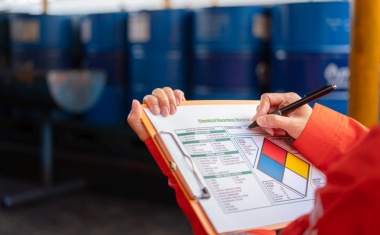The First Step To Sustainable Composites

Going Green - The global rise in environmental awareness has encouraged the use of more renewable materials. Composite materials represent one area that presents challenges - but also opportunities - for using sustainable materials. Market drivers such as sustainability programs, environmental health and safety requirements and "green" building programs are creating an incentive to develop bio-based composite products that also produce fewer emissions during different life-cycle phases.
One of the earliest notable efforts launched in 2003, when John Deere Corporation began producing side body panels for their equipment using Ashland's Envirez polyester resins. These resins are formulated using renewable and/or recyclable raw materials and support the manufacture of more sustainable composite products. Envirez polyester resins deliver reduced environmental impact, with lower carbon dioxide emissions and a diminished dependence on crude oil. These resins meet the same performance and processing requirements as petroleum-based UPR products and are commercially available in a wide variety of processes and applications within the building, marine and transportation markets.
Shift From Traditional Materials
More have come to believe that relying solely only on petroleum-based materials is not a tenable practice. One area that is experiencing a shift from traditional materials is commercial and residential construction. Green building programs strive to provide an energy efficient environment, improve environmental quality for inhabitants and reduce impact on surroundings. Buildings receiving a "green" designation are third-party certified through an established rating system. The rating systems most used are LEED (Leadership in Energy and Environmental Design) in the U.S.; BREEAM (BRE Environmental Assessment Method) in the U.K.; DGNB (German Sustainable Building Council) in Germany; and several other national systems. More information can be found through www.worldgbc.com pages, including links to national systems.
As an example, LEED was created in 1998 by the U.S. Green Building Council. Today, federal agencies, states and cities require public buildings to be LEED certified. Among the benefits from this program are responsible image, tax benefits, better occupancy rates and higher lease rates, employee wellness and productivity, and lower operating costs. Also investors get better value for the buildings. Composites can become connected to LEED certification as products or materials made with rapidly renewable and/or recycled materials. These products, when used in building construction, fit in the Materials & Resources category for the program.
How to Make Polyester From Renewable Resources
In the late 1990s, Ashland, in cooperation with the United Soybean Board and John Deere, began work to develop the first commercially viable bio-based resins. Ashland researchers created a polyester resin based, in part, on soybean oil and corn ethanol. This became the Envirez 1807 resin, which was first used to create sheet molding compounds (SMC). This enabled John Deere to realize its desire to have composite parts for tractors made from agriculture products. The resin also delivered the same performance as a 100 % petroleum-based product. When Envirez 1807 resin was first introduced, it contained 18 % renewably sourced materials.
Ashland continues to develop the Envirez resin range and has grown the product range to include several different applications in the building, marine and transportation industries. Research continues to develop polyester resins having ever-increasing renewable content. Several new raw-material opportunities are also being explored. In Europe, Ashland has developed its Envirez resin product range to include eight different products for applications that include hand lay-up, spraying, pultrusion, solid surface, cast marble, infusion and continuous lamination. Bio content in these resins can vary from 13-22 %.
Environmental Benefits of Using Resins from Renewable Resources
In collaboration with the United Soybean Board, Ashland also supported a third-party life cycle assessment of the original Envirez 1807 resin and a comparable petrochemical-based resin. The 2009 report, by Omni Tech International, showed Envirez 1807 resin consumes 4.0 MJ/kg (1720 BTUs/lb) less energy during manufacture than a comparable 100 % petrochemical resin. The calculation takes into account the energy consumed in manufacturing as well as by farming and processing soy and corn into oil and ethanol, respectively.
Thus, compared to the petrochemical resin, Envirez 1807 resin requires approximately 22 fewer barrels of crude oil to be extracted from the ground per standard (40,000 pound) batch. In addition, the study demonstrated the global warming potential impact for Envirez 1807 resin. When compared to the petrochemical resin, a standard batch of Envirez resin eliminates approximately 18,000 kilograms of CO2 from being released.
As the interest in moving to a more sustainable approach in manufacturing, building or any aspect of life increase, savvy manufacturers are adapting and delivering technologies to meet this demand. Composites represent just one aspect of this environment-focused movement.
Web Tip
At the Ashland-developed website, www.CompositeBuild.com, building professionals can find information and suppliers of composite products used in commercial and residential buildings.










